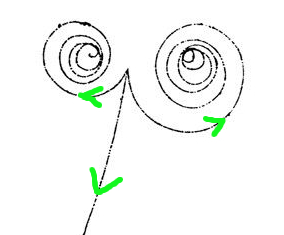

These properties of charge are illustrated in the above image, which shows the experimental creation and conservation of electrical charge. Here an invisible high-energy electrically-neutral light particle (photon) travels down from the top of the image and scatters off an invisible neutral hydrogen atom that is located near the middle of the figure, where the three curves meet at a cusp. The collision of the photon with the atom causes four particles to appear: a positively charged proton (not visible), a negatively charged electron knocked free from the hydrogen atom (this corresponds to the nearly straight track continuing downwards), and the creation of two new particles, a negatively charged electron and a positively charged antiparticle called a positron, whose paths trace out the two spirals.
Before the collision, the isolated system consisting of the liquid hydrogen in the bubble chamber was electrically neutral with a total charge of zero. After the collision and the creation of the electron-positron pair, the total electrical charge of this system remains zero since the created positron's charge has exactly the same magnitude e as the created electron's charge but is opposite in sign. How do we know this? Each of the three moving charged particles (the green arrow heads indicate the direction of motion) leave a wake of tiny bubbles of hydrogen gas as they plow through the super-heated liquid hydrogen in the bubble chamber, rendering their paths visible as continuous lines. An external magnetic field bends the paths of the electron and positron into oppositely oriented spirals whose geometric shapes can be used to deduce the sign and magnitude of their electrical charges, which turn out to be equal and opposite to the accuracy of this experiment. Note that the electron dislodged from the hydrogen atom (the middle curve moving downwards from the cusp toward the lower left) was moving too fast for the magnetic field to bends its path substantially.
Despite many advances in theoretical and experimental physics, including the development and confirmation of the Standard Model that explains a great diversity of experimental data concerning fundamental particles, many basic questions about electrical charge remain unanswered. We do not know why charge exists in the first place, nor why it has positive and negative values, nor why the fundamental unit of charge is the magnitude e of an electron, nor what determines the numerical value of e in some given set of units, nor why all charges are quantized in integer multiples of e, nor why the charge of a proton (a non-fundamental particle consisting of three quarks) is, within experimental error, identical to the magnitude of charge of an electron, which appears to be a point fundamental particle since no experiment has yet discovered any internal structure. However, we do understand from quantum field theory why charged antiparticles must have exactly the opposite charge and the same mass as the corresponding particle, and why all basic particles of a certain kind (electrons, positrons, protons) must be exactly identical.
Here are three questions about the above figure for you to think about: